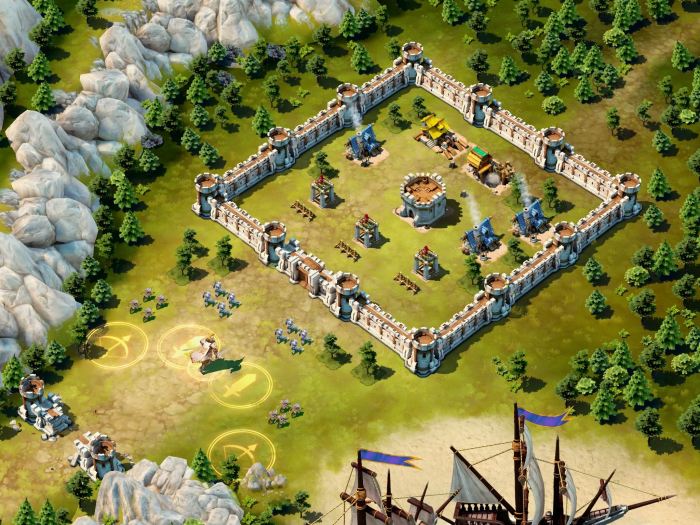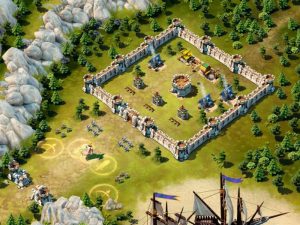
The realm of real-time strategy (RTS) games has been revolutionized by the advent of multiplayer features, transforming solitary battles into dynamic, competitive experiences. From the early days of “Dune II” to the modern era of “StarCraft II,” the evolution of RTS games has been intertwined with the growth of online gaming and the desire for shared strategic challenges.
This exploration delves into the fascinating history of RTS games with multiplayer features, examining the key innovations that shaped the genre and the enduring impact these games have had on gaming culture. We’ll explore the core mechanics that define these games, from resource management and unit production to base building and combat, and analyze how multiplayer features have shaped their development and popularity.
Popular Real-Time Strategy Games with Multiplayer Features

Real-time strategy (RTS) games have captivated gamers for decades with their blend of strategic planning, resource management, and fast-paced combat. Multiplayer features have become a defining characteristic of the genre, allowing players to compete against each other in intense and rewarding matches. This section delves into some of the most popular and influential RTS games with multiplayer features, exploring their key gameplay mechanics and cultural impact.
The Pioneers of Multiplayer RTS
The foundation of multiplayer RTS was laid by early games likeDune II* (1992) and
-
Warcraft
Orcs & Humans* (1994). These games introduced the core concepts of resource gathering, base building, unit production, and strategic combat, setting the stage for the genre’s evolution.
- Dune II* was particularly influential, pioneering the real-time strategy genre and establishing the core gameplay elements that would become synonymous with the genre. It introduced the concept of base building, resource gathering, and unit production, which were later refined and expanded upon in subsequent games.
- *Dune II* (1992): This groundbreaking game, often considered the first true RTS, introduced the core gameplay mechanics of base building, resource gathering, and unit production, setting the stage for the genre’s evolution. Its strategic depth and engaging gameplay made it an instant hit, paving the way for future RTS games.
- *Warcraft: Orcs & Humans* (1994): This game expanded upon the foundations laid by
-Dune II*, introducing more complex unit types, hero units, and a rich fantasy setting. Its multiplayer mode was particularly popular, fostering a competitive community that would continue to grow with subsequent installments.
The Rise of Competitive Multiplayer
The late 1990s and early 2000s witnessed a surge in popularity for RTS games, driven by the emergence of online multiplayer platforms and the development of increasingly sophisticated gameplay mechanics. Games likeStarCraft* (1997),
Age of Empires II
The Age of Kings* (1999), and
Warcraft III
Reign of Chaos* (2002) became esports staples, attracting millions of players and establishing a competitive scene that continues to thrive today.
- *StarCraft* (1997): This game, developed by Blizzard Entertainment, is widely considered one of the greatest RTS games of all time. Its balanced gameplay, diverse unit roster, and strategic depth made it a perfect fit for competitive play.
-StarCraft* became a global phenomenon, particularly in South Korea, where it was elevated to the status of a national sport. It spawned a professional scene with dedicated tournaments and leagues, and its legacy continues to influence the esports landscape. - *Age of Empires II: The Age of Kings* (1999): This historical RTS game, developed by Ensemble Studios, achieved immense popularity for its engaging gameplay, diverse civilizations, and expansive campaign mode. Its multiplayer mode, which allowed players to choose from different civilizations and compete in various game modes, became a major draw for players. The game’s enduring popularity is evident in its continued support and active community.
- *Warcraft III: Reign of Chaos* (2002): This fantasy RTS game, also developed by Blizzard Entertainment, built upon the success of its predecessors by introducing innovative features such as heroes with unique abilities and customizable item sets. Its multiplayer mode was highly competitive, fostering a thriving esports scene with tournaments and leagues. The game’s popularity extended beyond gaming, inspiring numerous mods and custom maps, and its legacy continues to influence the RTS genre.
Modern Multiplayer RTS: New Frontiers
The RTS genre continues to evolve, with modern games exploring new gameplay mechanics and embracing innovative technologies. Games likeCompany of Heroes 2* (2013),
StarCraft II
Wings of Liberty* (2010), and
Total War
Warhammer II* (2017) offer engaging multiplayer experiences that cater to both casual and competitive players.
- *Company of Heroes 2* (2013): This World War II-themed RTS game, developed by Relic Entertainment, focuses on realistic combat and tactical depth. Its multiplayer mode allows players to engage in intense battles across various maps and scenarios, utilizing different factions with unique units and abilities. The game’s emphasis on strategic planning and tactical execution makes it a popular choice for competitive players.
- *StarCraft II: Wings of Liberty* (2010): This sequel to the original
-StarCraft* expands upon the game’s core gameplay mechanics, introducing new units, abilities, and game modes. Its multiplayer mode remains a cornerstone of the game, with a thriving professional scene and a diverse community of players. The game’s competitive nature and strategic depth continue to attract players and esports enthusiasts alike. - *Total War: Warhammer II* (2017): This fantasy RTS game, developed by Creative Assembly, combines real-time battles with turn-based campaign gameplay. Its multiplayer mode allows players to engage in large-scale battles across the Warhammer fantasy world, utilizing different factions with unique units, abilities, and campaign objectives. The game’s blend of strategy and action, coupled with its rich lore and engaging gameplay, makes it a popular choice for both casual and hardcore players.
The Enduring Legacy of Multiplayer RTS
Multiplayer RTS games have had a profound impact on the gaming industry, influencing the development of other genres and fostering a vibrant esports scene. Their strategic depth, competitive nature, and enduring popularity have cemented their place in gaming history. These games have also contributed to the growth of online gaming, providing platforms for players to connect and compete from around the world.
“Real-time strategy games are a testament to the enduring power of human ingenuity and creativity. They offer a unique blend of strategic planning, resource management, and fast-paced combat, providing an unparalleled level of challenge and satisfaction.”
Related Game Genres

Online games represent a vast and diverse landscape, encompassing various genres catering to different player preferences and interests. These genres often overlap, with many games blending elements from multiple categories. Understanding these genres is crucial for gamers seeking specific experiences and for developers aiming to create engaging and successful titles.
Online Game Genres
Online game genres offer a diverse range of experiences, from action-packed adventures to strategic battles and immersive simulations. These genres are characterized by their online multiplayer features, allowing players to interact and compete with others worldwide. Here’s a breakdown of some prominent online game genres:
| Genre | Description |
|---|---|
| Online Games Adventure | These games typically involve exploration, puzzle-solving, and narrative-driven experiences. Players often embark on quests, interact with characters, and uncover hidden secrets. Examples include World of Warcraft, Final Fantasy XIV, and The Elder Scrolls Online. |
| Online Games App | This category encompasses games designed for mobile devices and accessible through app stores. They offer a wide range of genres, from casual puzzle games to action-packed shooters. Popular examples include Candy Crush Saga, Clash of Clans, and PUBG Mobile. |
| Online Games Anime | Inspired by anime series and manga, these games often feature stylized graphics, vibrant characters, and storylines rooted in Japanese animation. Examples include Sword Art Online: Fatal Bullet, Genshin Impact, and Black Clover: Quartet Knights. |
| Online Games Arcade | These games are reminiscent of classic arcade experiences, often featuring fast-paced action, simple controls, and high scores. Examples include Pac-Man, Tetris, and Street Fighter. |
| Online Games Best | This category encompasses games considered the best in their respective genres, often based on player ratings, critical acclaim, and popularity. Examples include League of Legends, Dota 2, and Counter-Strike: Global Offensive. |
| Online Games Barbie | Targeted towards a younger audience, these games feature the iconic Barbie doll and often revolve around fashion, beauty, and social interactions. Examples include Barbie Dreamhouse Adventures and Barbie Life in the Dreamhouse. |
| Online Games Batman | Based on the iconic superhero, these games typically involve action, stealth, and crime-fighting. Examples include Batman: Arkham Asylum, Batman: Arkham City, and Batman: Arkham Knight. |
| Online Games Bus | These games simulate the experience of driving a bus, often involving passenger transportation, route management, and realistic driving mechanics. Examples include Bus Simulator 18, City Bus Simulator, and OMSI 2. |
| Online Games Bingo | These games are based on the traditional bingo game, often featuring online chat rooms, social interaction, and various themed variations. Examples include Bingo Blitz, Bingo Bash, and Jackpot Bingo. |
| Online Games Business | These games involve building and managing virtual businesses, often involving resource management, market competition, and strategic decision-making. Examples include RollerCoaster Tycoon 3, SimCity, and Capitalism Lab. |
| Online Games Car Racing | These games focus on competitive racing, featuring realistic physics, diverse tracks, and a wide selection of vehicles. Examples include Forza Horizon 5, Gran Turismo 7, and Need for Speed. |
| Online Games Cards | These games involve playing various card games, such as poker, blackjack, and bridge, often featuring online tournaments, social interaction, and different game variations. Examples include PokerStars, Zynga Poker, and World Series of Poker. |
| Online Games Competition | These games emphasize competitive gameplay, often involving tournaments, leaderboards, and rewards for skilled players. Examples include League of Legends, Dota 2, and Counter-Strike: Global Offensive. |
| Online Games Disney | These games feature characters and themes from Disney films and television shows, often targeting a younger audience. Examples include Disney Heroes: Battle Mode, Disney Magic Kingdoms, and Disney Emoji Blitz. |
| Online Games Driving | These games simulate driving experiences, ranging from realistic simulations to arcade-style racing. Examples include Forza Horizon 5, Gran Turismo 7, and Need for Speed. |
| Online Games Strategy | These games emphasize strategic planning, resource management, and tactical decision-making. Examples include Age of Empires IV, StarCraft II, and Civilization VI. |
| Online Games Solitaire | These games are based on the classic solitaire card game, often featuring different variations and online leaderboards. Examples include Microsoft Solitaire Collection, Spider Solitaire, and Klondike Solitaire. |
| Online Games Soccer | These games simulate the sport of soccer, featuring realistic gameplay, team management, and online competitions. Examples include FIFA 23, Pro Evolution Soccer, and Football Manager. |
| Online Games Steam | This category refers to games available through the Steam platform, a popular digital distribution service for PC games. Examples include Counter-Strike: Global Offensive, Dota 2, and Grand Theft Auto V. |
| Educational Games | These games aim to educate players on various subjects, often incorporating interactive elements, challenges, and rewards. Examples include Minecraft: Education Edition, Kerbal Space Program, and SimCity. |
| Sports Games | These games simulate various sports, often featuring realistic gameplay, team management, and online competitions. Examples include FIFA 23, NBA 2K23, and Madden NFL 23. |
| Strategy Games | These games emphasize strategic planning, resource management, and tactical decision-making. Examples include Age of Empires IV, StarCraft II, and Civilization VI. |
As technology continues to advance, the future of RTS games with multiplayer features holds exciting possibilities. Virtual reality and artificial intelligence could reshape the genre, offering new ways to experience strategic gameplay and engage with virtual worlds. Whether we see the rise of entirely new game mechanics or refinements to existing ones, the legacy of RTS games will undoubtedly continue to influence the landscape of online gaming for years to come.
Top FAQs
What are some of the most popular RTS games with multiplayer features?
Some of the most popular and influential RTS games with multiplayer features include “StarCraft II,” “Age of Empires II: Definitive Edition,” “Warcraft III: Reign of Chaos,” “Command & Conquer: Red Alert 2,” and “Total War: Warhammer II.” These games have captivated players with their diverse factions, strategic depth, and competitive multiplayer modes.
How do multiplayer features enhance the gameplay experience in RTS games?
Multiplayer features add a layer of competition and collaboration to RTS games, enhancing the gameplay experience in several ways. Players can test their skills against others, learn from their mistakes, and build a sense of community. Multiplayer modes also provide a platform for strategic experimentation, fostering innovation and creative approaches to gameplay.
What are some of the challenges involved in designing and balancing multiplayer RTS games?
Balancing multiplayer RTS games is a complex task that requires careful consideration of factors such as unit strengths, resource acquisition rates, and map design. The goal is to create a fair and engaging experience for all players, ensuring that no single faction or strategy dominates the game. This often involves ongoing adjustments and updates based on player feedback and competitive results.




